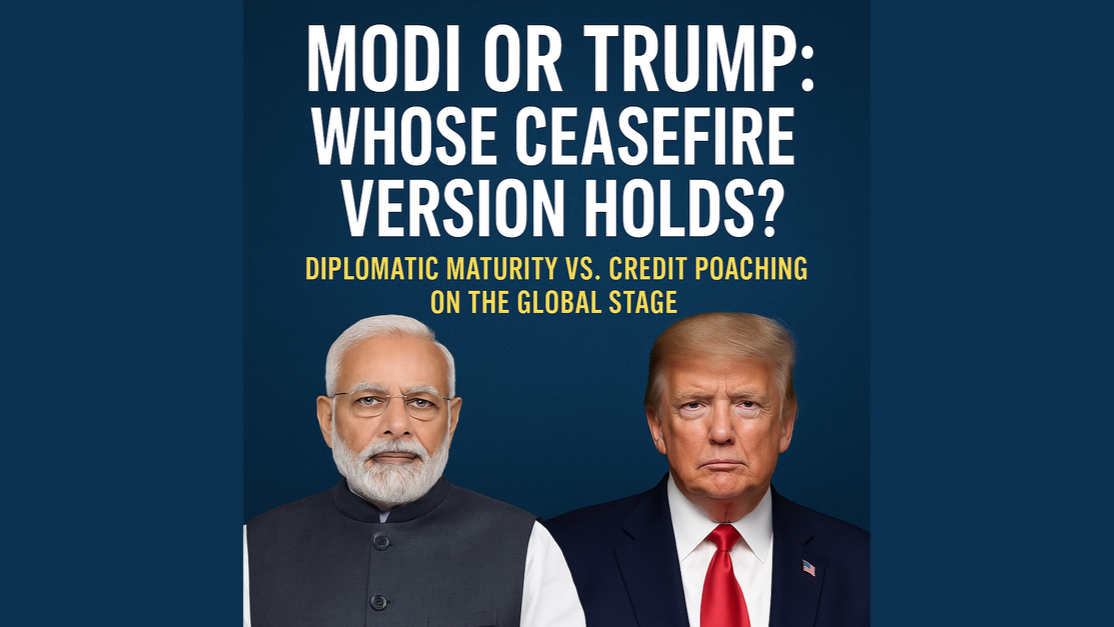 Diplomatic Maturity vs. Credit Poaching on the Global Stage
Diplomatic Maturity vs. Credit Poaching on the Global Stage
The recent ceasefire between India and Pakistan has once again brought into focus the delicate game of global perception, and how leaders position themselves before domestic and international audiences. On Truth Social, former U.S. President Donald Trump was quick to claim credit, rushing to announce victory like a glory hungry contender at the podium eager to declare victory even before the microphones are unwrapped. (Those who know him say that Trump compares himself with Obama and resents that he won the Noble Peace Prize and he hasn’t)
Trump’s statement, ostensibly congratulating both countries, came across as patronizing. More significantly, it reflected his persisting attempt (after his customary condolence on truth social and his call to Modi on 22nd April) to “hyphenate” India and Pakistan—treating them as equivalent rivals in need of American mediation.
Since the Pahalgam attack Trump has tried to place Indian Prime Minister Narendra Modi and Pakistani Prime Minister Nawaz Sharif on the same moral and strategic plane. In doing so, he subtly undermines India’s longstanding position that there is no equivalence between a democratic, rule-based power like India and a militarized, often radicalized Pakistan. His comment that he would “work with both countries to see if a solution to the Kashmir issue can be found” ignored the Indian position entirely—and, worse, assumed a mediator role India has repeatedly and formally rejected.
India, for its part, maintained a dignified silence. But Trump seemed to anticipate a public statement from Modi that could reveal the actual nature of the ceasefire. Eager to seize the narrative, Trump tried to pre-empt it by a few minutes with remarks delivered on May 12 in Washington, D.C.:
“I said, come on, we’re going to do a lot of trade with you guys. Let’s stop it. If you stop it, we’ll do a trade. If you don’t stop it, we’re not going to do any trade.”
He went on to add,
“People have never used trade the way I use it, and that I can tell you,” a line that read more like a rhetorical flourish meant to make an implausible claim palatable.
The language felt over compensatory—defensive, even. Seemed like extra words were trying to cover a truth. Later, Trump tried to rewrite the timeline, claiming almost as an afterthought that “suddenly, they announced the ceasefire… for a lot of reasons, but trade is a big one,” implying that, even if belatedly, events unfolded as he had orchestrated.
When Modi finally addressed the nation at 8 p.m., the tone and content of his speech delivered a quiet but unmistakable rebuttal. The United States was conspicuously absent from his remarks. This was not just an omission—it was a mature denial. More than that, Modi emphasized that Pakistan had been pleading, not negotiating. It was a rhetorical flourish that underlined India’s assertion of strategic and moral high ground, and the fact that the outcome was the result of India’s own firm action—not external mediation.
The Ministry of External Affairs (MEA) later confirmed that trade was never discussed in the talks. Soon after, India announced retaliatory tariffs against the United States at the World Trade Organization. This again was calibrated but unmistakeable message—India would not be lectured or manipulated, even by a superpower.
The slight to India—and to Prime Minister Modi, who may helm a smaller economy but frequently demonstrates far more diplomatic restraint and foresight—began with Trump’s grandstanding at their February press conference in Washington and has continued since. But in the past 48 hours, the U.S. administration encountered what can only be described as a reverse snub – with silence speaking louder than spin.
Indeed sometimes, the loudest thing you can say… is nothing at all.